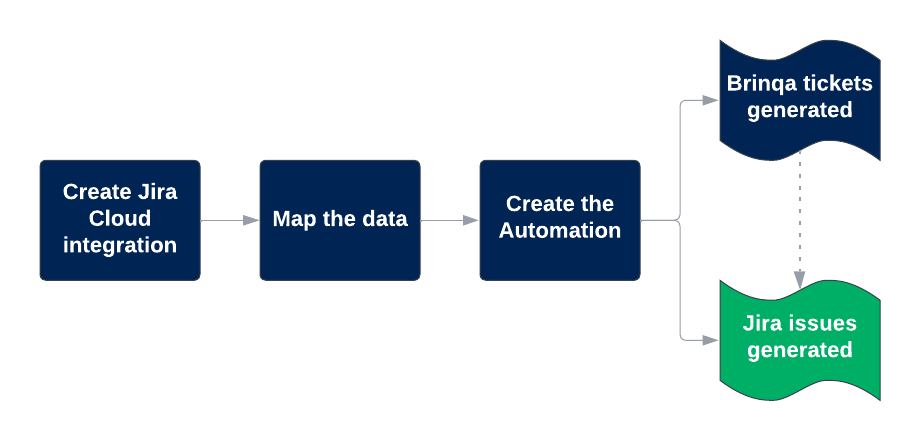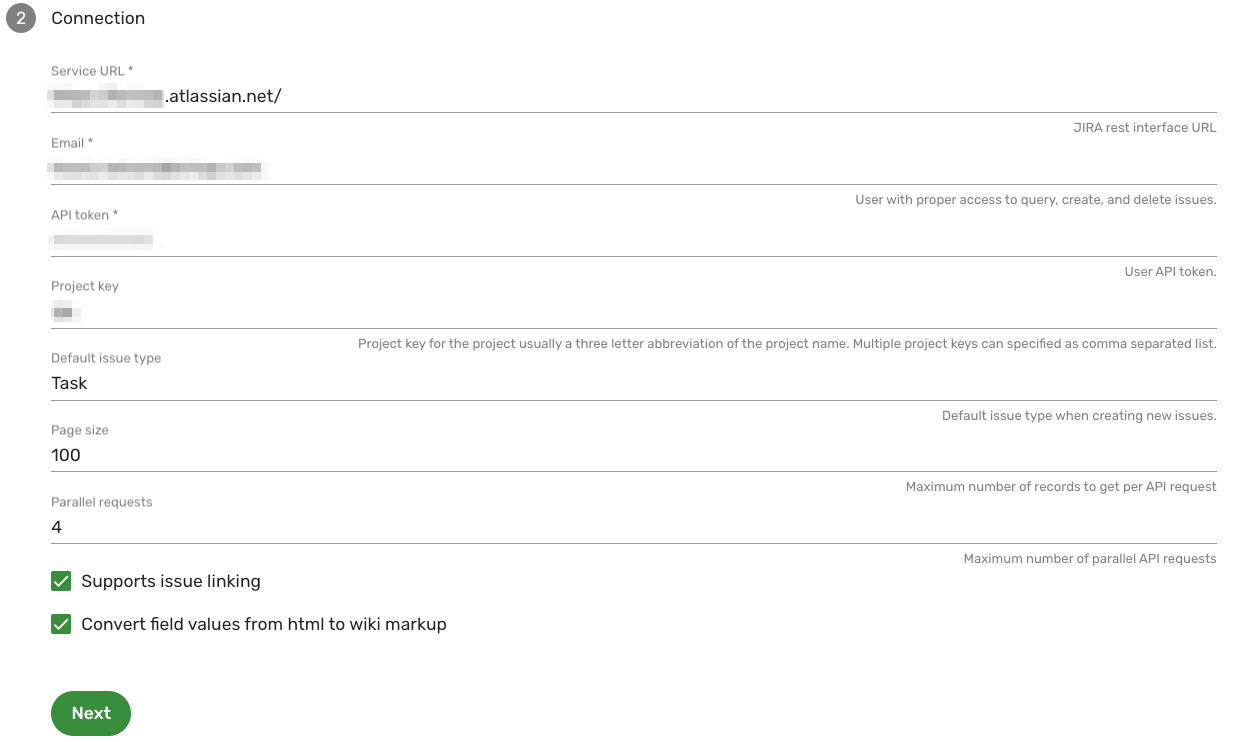Synchronize Tickets with Jira
You can synchronize tickets created in your Brinqa Platform with outside ticketing systems, such as ManageEngine, Jira or ServiceNow. This article details how to send tickets to your organization's Jira project boards.

1.) Create data integration for Jira Cloud
Before you can synchronize tickets between the Brinqa Platform and your organization's Jira project board, you need to install and use the Jira Cloud connector in a data integration. Only users with the System Administrator role can create data integrations. To do, follow these steps:
-
Navigate to Integrations > Connectors.
-
Locate the Jira Cloud connector and click Install.
-
Click Use. The Create data integration screen displays.
-
Fill out the General information.
-
Title: Provide a title for the data integration. For example, "Jira Cloud."
-
Connector: The Connector field is filled in with the Jira Cloud connector.
-
Server: The server to process the data integration. Local server is selected by default for cloud data sources. You can also create your own data servers for on-premises data sources.
-
Description: Provide a description for the data integration. For example, "Jira Cloud data integration for ticket sync."
-
-
Fill out the Connection information for the Jira Cloud connector.
-
Service URL: Your organization's Jira Cloud URL. The default format is
https://<OrganizationName>.atlassian.net/ -
Email: Your company email address. This user must have proper permissions to query, create, and delete issues in your Jira project.
-
API token: The User API token for your Atlassian account. If you are unsure of your Atlassian API token or do not know how to create one, see Create an API token for your Atlassian account.
-
Project key: The key of the Jira project you want to push the Brinqa tickets to. This project key is typically a three or four-letter abbreviation of the project name, such as
OPSfor your DevOps team. You can enter multiple project keys separated by commas. The project key is usually in all uppercase letters. -
Default issue type: The default issue type when creating new issues. For example, Bug, Task, Improvement, New Feature, and etc.
-
Leave Page size and Parallel requests as is.
-
Supports issue linking. Select this option to enable the action of syncing tickets between your Brinqa Platform and your Jira project board.
-
Convert field values from html to wiki markup: Converts html text in markup language. Select this option to convert formatted fields from Jira to wiki markup so that they can be displayed in Confluence.
Your connection settings may resemble the following:

-
-
Click Next.
-
For Types, choose Issue.
-
For Sync Interval, choose how far back you want to sync your data. By default, the beginning of time is selected, which means when the ticket is created in your Brinqa Platform. You can leave this field as is.
-
For Data lifecycle, specify the number of days of inactivity after which the data retrieved by the Jira Cloud integration is marked as inactive and then removed from the Brinqa Platform. The default is 30 days. See Data lifecycle management for additional information.
-
Click Create.
If you have completed the fields correctly, the page reloads and you should see the Jira Cloud data integration listed. If you do not see it, click Refresh .
The Jira Cloud data integration syncs when the data orchestration runs.
2.) Configure data mapping for Jira Cloud
After creating the Jira Cloud data integration, you need to create a data mapping to sync the tickets created in the Brinqa Platform to your Jira project. To do so, follow these steps:
-
Navigate to Integrations > Sources.
-
Hold your pointer over the Jira Cloud data integration, click the kebab (three vertical dots) menu, and then click Mappings.
-
Click Create and fill in the following fields:
-
Title: Provide a title for the data mapping. For example, "Brinqa to Jira."
-
Source: The data model containing the data you want to push. Select Vulnerability ticket.
-
Target: The data model selected for Types in the Jira Cloud data integration. Click the drop-down and select Issue.
-
-
Click Map attributes. Mapping source attributes to targets lets you match aspects of the Brinqa tickets that are pushed to the Jira project board.
-
Click the desired source attribute, use Search if needed, and then click the target attribute. A line displays, linking the mapped attributes.
For the best compatibility and consistency between tickets created in the Brinqa Platform and Jira, the following mappings are highly recommended:
Source Target Assigned Assignee Description Description Due date Due date Name Summary Status Status noteAlthough Issue Type and Project are marked as required, they don't need to be manually mapped, as these fields are already provided and mapped automatically in the connector configuration.
-
Click Preview to ensure that the source attributes and targets align.
-
Click Create.
You can create multiple mappings for the same data integration. Different Jira projects may require specific mappings based on the fields of the Jira project.
3.) Create ticket sync automation
You must create an automation to generate tickets in your Brinqa Platform and then push those tickets to your organization's Jira account. Only users with the Configurator or System Administrator role can create automations. To create tickets for critical vulnerabilities and send them to Jira, follow these steps:
-
Navigate to Automation.
-
Click Create and fill in the following fields:
-
Title: Provide a title for the automation. For example, type "Jira Ticket Sync."
-
Description: Provide a description for the automation. For example, type "Sync tickets in Brinqa Platform to Jira."
-
-
Type the following Brinqa Query Language (BQL) query to find all critical vulnerabilities in your data:
FIND Vulnerability AS v WHERE v.riskRating = "Critical"warningAvoid using "Finding" in the BQL query. Instead, choose a data model that extends the "Finding" model, such as Alert, Manual finding, Pentest finding, Violation, Vulnerability, etc. If you create an automation for generating tickets and use "Finding" in the BQL query, it will not work as intended and will result in tickets being created with empty counts.
-
Click Test to ensure your query is valid and returns data.
-
In Actions, there are different ticket types and methods in which you can generate tickets:
-
Create ticket without sprints: Use this option if you don't want to associate the ticket with a sprint. More options display, excluding sprint settings. See Create tickets without sprints for additional information on setting that up.
-
Create ticket with sprints: Use this option if you want to associate the tickets with a sprint. More options display for sprint settings. See Create tickets with sprints for additional information on setting that up.
-
-
Click Add action and select Push vulnerability tickets. More options display.
- For Data integration mapping, select the mapping created for your project in the configure data mapping for Jira Cloud section.
-
For Run, choose the method in which the automation runs.
-
Manual: Manually launch the automation from the Automation page.
-
Schedule: Specify a schedule for the automation to run (for example, once per day, every day at a specified time).
-
Orchestration: Set the automation to run as part of the data orchestration
-
-
Click Create.
4.) Launch the ticket sync automation and view tickets
The final step in synchronizing tickets in your Brinqa Platform with your Jira project board is to launch the ticket sync automation. To do so, follow these steps:
-
Navigate to Automation.
-
Hold your pointer over the Jira ticket sync automation and click Run.
-
Click Confirm when prompted.
-
After a successful run of the automation, navigate to Remediation > Tickets > All.
-
To view tickets generated by the automation, click the Sources filter, select Jira Cloud, and then click Apply.
- If you do not see the Sources filter, click More, select Sources, and then click Apply.
-
Hold your pointer over one of the tickets and click Details to view the details. These details include a summary of the vulnerability, recommendations on how to address the vulnerability, risk and SLA information, and more.
-
Log in to your Jira project board to view the tickets created from the ticket sync automation in your Brinqa Platform.
Troubleshooting
If your ticket sync automation fails, you can view information on what has caused a step in the automation process to fail. To do so, follow these steps:
-
Navigate to the Automation page and select the automation you want to view the logs for.
-
Copy the Transaction ID of the failed automation.
-
Navigate to Administration
on the upper-right corner and under System, select Logs.
-
Paste the Transaction ID into the search bar and press Enter or Return on your keyboard.
-
If you click the link in the Message column, you can see what has caused the automation to fail. The error message is included in the Detail section.